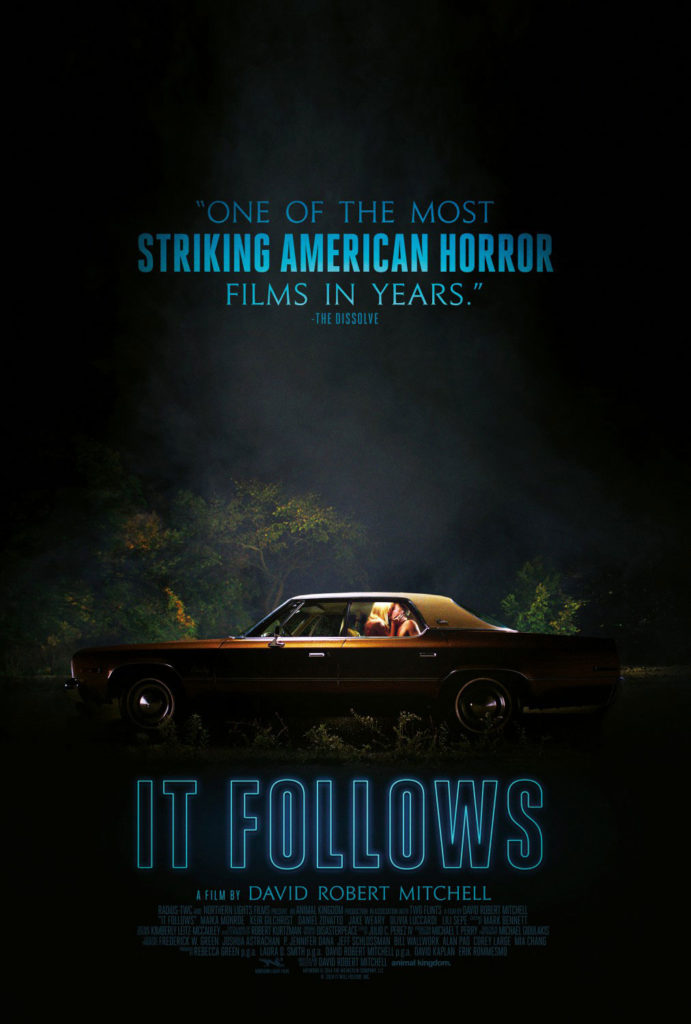Umm...is this film mumblegore? No, it’s not. It Follows is the second feature film from David Robert Mitchell. He’s not one of the crew of filmmakers (Ti West, Adam Wingard, etc.) that have steered much of horror back to a 1970s sense of place, setting, and look and feel, but Mitchell’s film does feel like kin in many ways. I think this has a lot to do with the wider aesthetic that has come to dominate still photography in recent years. Every one of us with a smartphone has participated in it at some point. We’ve had Instagram accounts or the Hipstamatic app or any number of other apps that apply retro filters to our pics. And since everyone in this country seems to have a smartphone, the typical smartphone pics are everywhere, not just on our phones. The aesthetic is so popular that it has invaded advertising — the final indicator of cultural pervasiveness.
I bring this up not to imply that It Follows has a look and feel that is overdone. Rather, it has a look and feel that is readily recognizable. Funny enough, while this aesthetic is everywhere one looks, it has yet to make its way into mainstream Hollywood films. Hmm.
No matter. Because while It Follows has a look with which we are all familiar, Mitchell and cinematographer Mike Gioulakis shot their film with consummate skill. Scene after scene is composed as if each really were still photographs, as if we viewers are not in a  theater or a living room, but are instead gazing at framed pictures on a gallery wall, and then all of a sudden they come to life. Every shot in this film appears to have been considered in depth and is a joy to look at from beginning to end.
theater or a living room, but are instead gazing at framed pictures on a gallery wall, and then all of a sudden they come to life. Every shot in this film appears to have been considered in depth and is a joy to look at from beginning to end.
There’s also a pretty good horror flick in here, too.
It Follows has a simple premise that is so silly I cannot believe a good film was made from it. In this flick, a murderous supernatural entity stalks and kills hapless victims. But, it is how the entity chooses its victim that is the hook. It is transmitted sexually. One becomes a target of the entity by having sex with someone else who is being stalked. Now the entity will stalk the newest person while leaving the previous one alone. This new person has to have sex to pass on the entity before it kills them. If the entity manages to kill whomever it is stalking, it will then stalk the previous person, jumping up and down the line depending on how lucky or unlucky a person has been in getting laid.
An idea like this should not work, but it does. Mitchell, it turns out, is very good at building tension. He does this by making sure the entity has a decent amount of screen time. This goes against much of horror convention, where generally the less the audience sees of the baddy the better, but the entity’s many appearances in this film are essential. Rather than a popup demon that springs shock scares on a viewer, this entity is slow and methodical. It approaches its potential victims at a walk, sometimes taking on the appearance of someone the victim knows. But it never speaks. It never runs. It is never anything less than deliberate, and, unless caught unawares, easily escapable. But, it will always come. I can’t think of any other monster in horror cinema that is this slow yet instills so much dread.
An idea such as Mitchell’s could easily have been turned into a shit show of a teen horror flick — something akin to Final Destination — but Mitchell had something else in mind. He shows a good sense of pace and has skill as a storyteller. At times the pace does slow to a crawl, blurring the line between being as deliberate as the killer entity and being somnambulistic, but Mitchell always saves things in time. My biggest gripe is that the dialogue is far too quiet. It is part of the general atmosphere of the film, and was useful in keeping the cast members’ performances understated and nuanced, but I missed a whole mess of spoken lines because they were softer than a whisper.
Once the viewer is made aware of what is happening during the first act, It Follows becomes a study in tension all the way to the end. I cannot help but respect and admire any horror film that can successfully use tension to convey its fright. It’s the highest degree of difficulty in the genre, and Mitchell and company nailed it.
